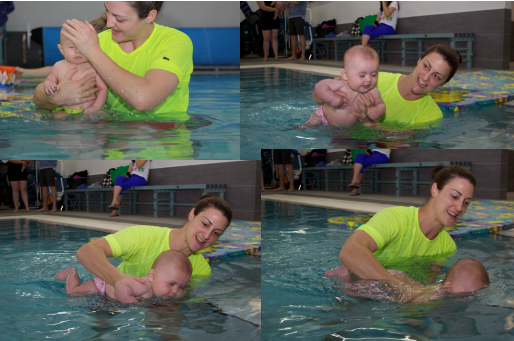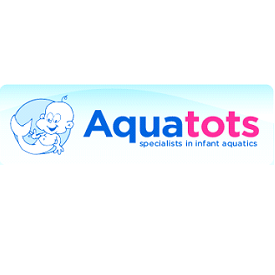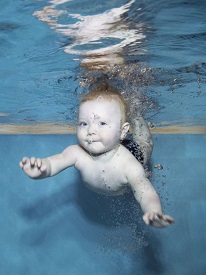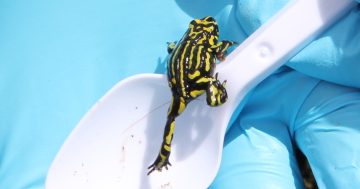With the weather warming up and more and more parents venturing to the pool to cool off and have a bit of fun with their little ones we thought it would be a good time to go over the technical side of submerging children under the age of three.
It is extremely important that parents are fully aware of the dangers of submerging babies that have not been conditioned to submerge correctly. Not only will you end up having a child that will have a fear of swimming or the water but your are also running the risk of secondary drowning (www.m.webmd.com/children/features) and or Hyponatremia/water intoxication (m.pediatrics.aappublications.org) Without waiting until your baby is conditioned to submerge by placing them underwater their air way will be open and the water that enters the mouth will go straight into the stomach and lungs. Most babies under the age of one will not complain if they are being submerged incorrectly which make this age group extremely dangerous.
At Aquatots we fully condition our babies to submerge and below are our tips and tricks so you can also have a happy and safe time in the water with your baby.
Up until the age of three years old your baby has a reflex that we use for submerging. The reflex we use to condition the babies is a falling reflex, when your baby shuts their eyes their epiglottis (throat) will close over as well. To teach your baby to use this reflex on cue we add the words 1,2,3 under and engage the baby’s reflex. With enough practice you will find your baby will hear the words 1,2,3 under and will shut their eyes on cue and that is when they are ready to submerge.
To condition your baby to engage this reflex on cue use a wet hand, wash cloth or a small amount of water in a bucket or cup. Use the cue 1,2,3 under and gently wipe or pour the water over your babies face. Eventually your baby will hear the words and will shut their eyes on cue. This conditioning can be started from birth.
It is important you allow your baby to learn the cue and engage the reflex before you attempt submerging. Waiting until your baby is ready will mean the outcome will be a comfortable relaxed swimmer.
Once your baby has learnt the verbal cue it is time to move onto submerging. Keep in mind that your baby does have two cues. The verbal (1,2,3 under) and a physical cue, which is a small lift on the word under. You must hold your child horizontal in the water as a vertical submersion will push the water up their nose (this stings). Move with your baby; ensure you can see their face, and use the verbal cue, lift on the word under and if your babies eyes are shut they are ready to submerge. Focus on your babies eyes not their mouth. If they eyes are closed the airway will be as well so even if their mouth is open the water can not get passed the throat.
At this point you will also need to be reading your babies face and body language to ensure they are relaxed and ready for the submersion. If your babies body seems tight or they are straining to keep their head up or if they are saying or making no sounds or gestures please DO NOT submerge. Allow your baby to ease in and become relaxed with what you are about to do. All your movements when submerging your baby must be smooth and controlled. Try to use natural movement and not force your child through the water. Babies under the age of three do not have enough neck strength to hold their head forward against the strength of the water so when forcing or pushing through the head will tip back and the water will go up their nose (this stings). Fast and sudden movements also tend to startle and frighten babies. When a baby is startled they will throw their arms outwards and take a breath in. If this happens underwater your baby will not only be shocked and unhappy but they will have had a big gulp of water. Making your movements gentle and smooth will be paramount to your babies enjoyment of their time under the water.
The main aim of your submersions will be for you as the parent or guardian to relax and allow your baby to submerge when they are comfortable and ready. The end result will ensure your baby will have maximum enjoyment above and under the water.

If you have any questions on submerging your baby please feel free to contact us.
Alena Sarri (manager Aquatots Swim School)
Aquatots is a My Gungahlin Platinum Sponsor www.mygungahlin.com.au/business-directory/aquatots-swim-school-forde


The views and opinions expressed in this post are soley those of the original author. These views and opinions do not necessarily represent those of My Gungahlin.
Do you want to feature on My Gungahlin? We’re looking for new stories from you! Send us a story (300-500 words) with photos about everything from:
- Gungahlin news
- Gungahlin history
- Gungahlin reviews
- Gungahlin sports results
- Your Gungahlin story
And whatever else you think would be relevant. Send your stories to [email protected]and we will let you know when we can publish your story!
My Gungahlin reserves the right to determine suitability. Please contact us to discuss promoting for business.













